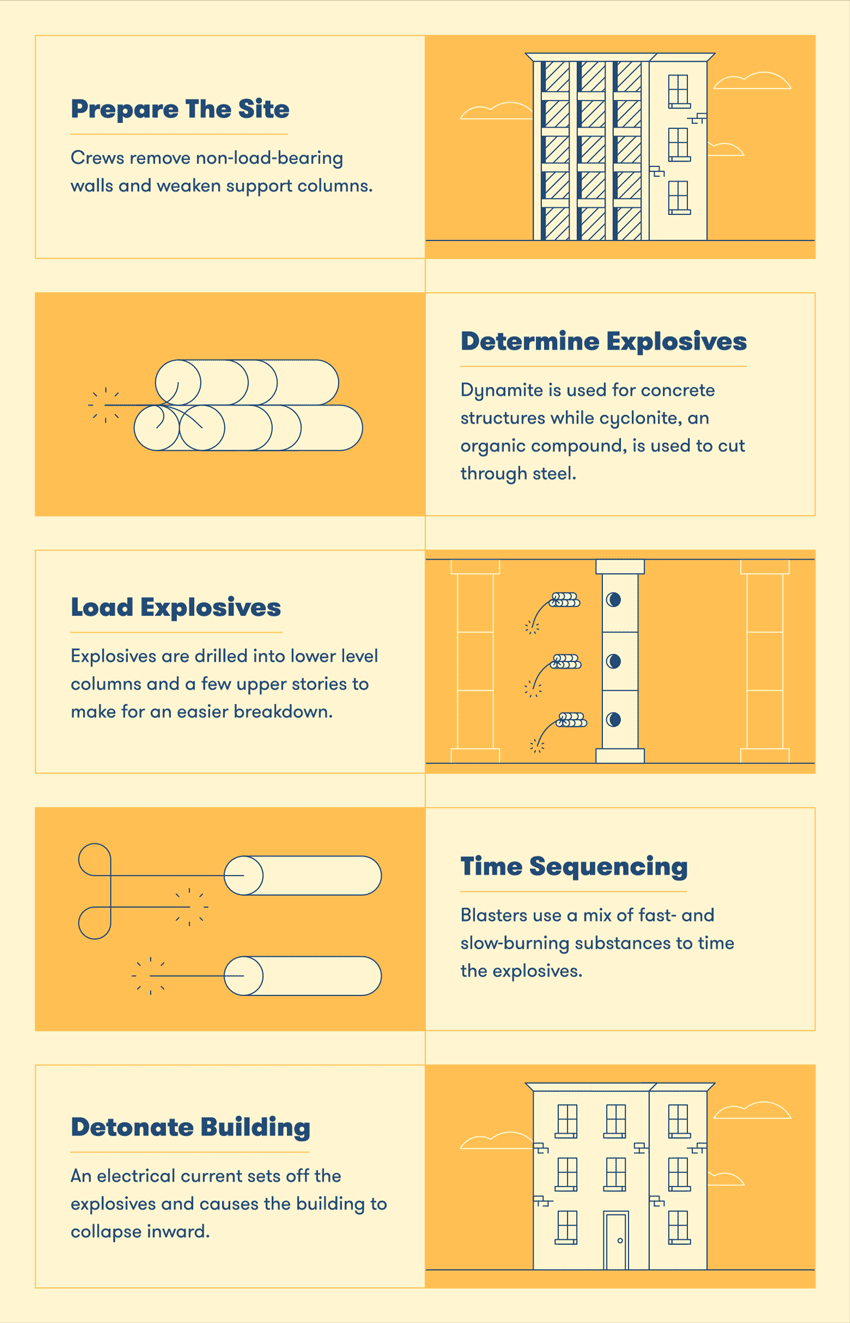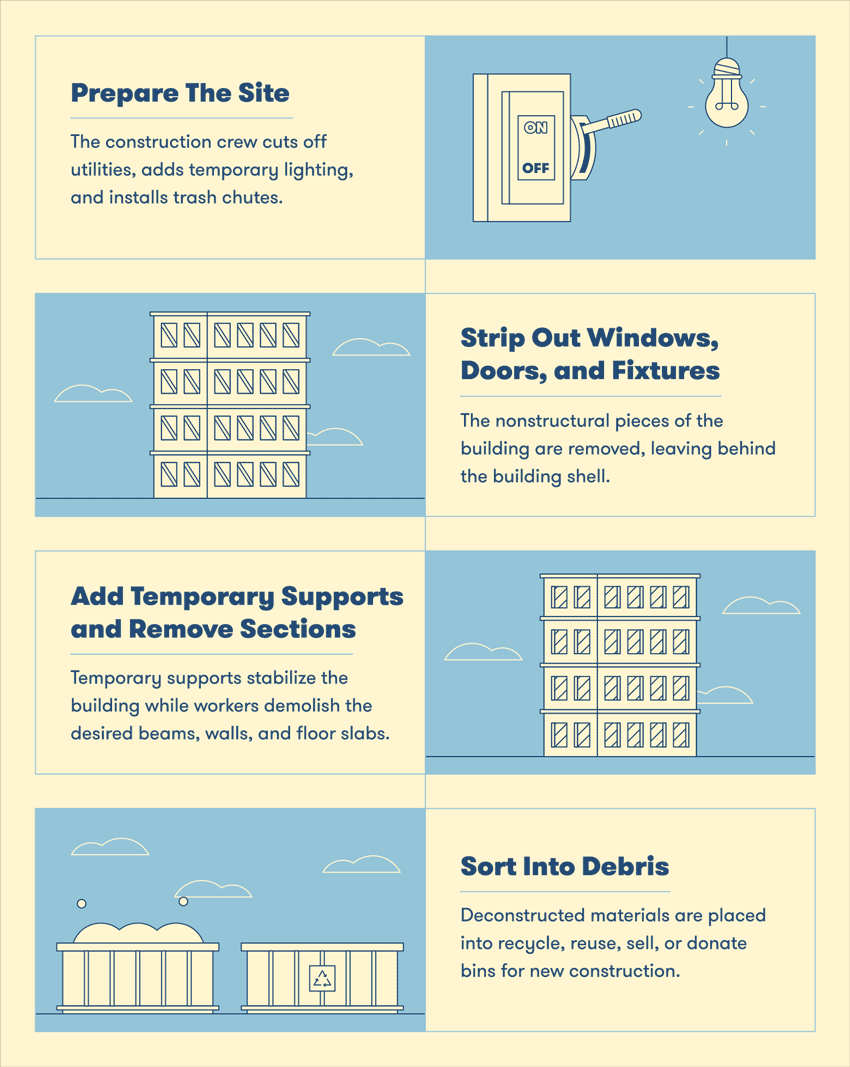Demolition is probably one of the most interesting parts of construction work. As we build more structures, there comes a point where we need to demolish old ones, either for safety reasons or to make room for newer buildings.
Demolition is the process of dismantling a building by pre-planned or controlled methods. However, there’s more to demolition than swinging a wrecking ball — it involves highly trained experts working with debris, weather conditions, materials, mass, and physics. Methods vary accounting to the type of building that is being demolished.
As the construction industry continues to see growth, demolition work is expected to grow at a rate of 3.3% through 2022. Read on to learn about the science behind demolishing a building and why it’s an important part of our communities. Jump to our infographic below to see a summary of the entire demolition process.
Pre-demolition Process
Before a demolition is executed, the experts must consider several different factors. A demolition process is customized for each project and typically involves the following steps.
- Building survey: Experts examine the different characteristics of a building, such as the materials, building usage, method of construction, condition, draining conditions, traffic conditions, building codes, and neighboring communities. A study of these parameters will help to dictate the best demolition method.
- Removal of hazardous materials: Specialized personnel is called upon to remove dangerous materials from the building prior to demolition, such as asbestos minerals, radioactive substances, flammable materials, and petroleum contamination.
- Demolition plan: Experts craft a detailed plan illustrating what will be involved in the demolition, how it will be carried out, the equipment that will be used, and how much debris they will need to clean up.
- Safety measures: Site workers, supervisors, operators, and engineers are advised of potential hazards such as flammable materials and exposure to noise and dust. The demolition company must also secure the proper permits.
The next step is to select the safest and most efficient demolition method that stays within budget. Not all demolitions end in explosions — methods can range from devastating blasts to non-explosive piece-by-piece removals. Some include implosions, excavators, wrecking balls, bulldozers, and selective demolition.
Building Implosion
Implosion is by far the most impressive method of demolishing a building. However, due to their specialized nature, implosions are used in less than 1% of demolition projects. Implosion is the process of using explosives to knock out a building’s main supports, causing the building to collapse from the inside out.
Buildings are imploded in one of two ways. If space permits, explosives are fitted into the building’s left columns, making it fall to the side when detonated. Cables are often used to control the building’s collapse, making this method a safer option. If space is limited, the second method involves placing explosives in the building’s lower support system and middle sections, causing the building to fall onto itself.
Implosions require the knowledge of experts called “blasters” and are often used to demolish large structures in urban areas. A successful implosion requires the following steps:
- Blueprint examination: Blasters study blueprints of a building to determine which areas need to be blasted.
- Site preparation: Crews prepare a site by taking out the non-load-bearing walls, weakening supporting columns, and wrapping columns with fencing for a cleaner fall with less flying debris.
- Determine explosives: Blasters select an explosive based on the building’s materials. Dynamites release shockwaves and are best used to obliterate concrete columns. RDX can expand up to 27,000 feet per second to slice through steel structures.
- Load explosives: The explosives are bored into columns, generally in support columns and a few upper stories to make it easier to break the building into smaller pieces.
- Time detonation: Blasters first build up an electrical charge. When the current is sent through the wire, it heats up and ignites the flammable substance, setting off the main explosives. Blasters can time their detonations by setting slow-burning materials to delay the explosions.
Excavator Demolition
For smaller buildings like homes and offices, an excavator is often used to dismantle the structure. However, buildings over 60 feet tall, as well as those made of masonry, concrete, and steel, will require a more heavy duty machine like a high reach excavator. High reach demolition is considered a cleaner, safer way to dismantle structures, as it causes less flying debris, dust, noise, and risk to the operator. Reduced noise pollution from high reach demolition helps protect the safety of surrounding communities.
The building itself is demolished mainly from the attachments affixed to the excavator. The most common are shears, crushers, and hydraulic hammers. The tool-equipped arm pulls down and breaks the structure from the top down. Special ground crews then use hammers, sledgehammers, and crushers to reduce the pieces to rubble.
The right boom size will depend on the building. High-rise buildings like a hotel often have lighter steel at the top, so a taller boom height should be prioritized over a heavy tool. An industrial building, on the other hand, will require a heavy tool to remove thicker materials and thus a boom that can handle more weight instead of height.
Wrecking Ball Demolition
A wrecking ball is the classic icon of demolition. A massive ball of steel weighing up to 12,000 pounds is suspended from a crane and swung into a building, with its sheer weight, inertia, and gravity doing the work to bring down a building.
There are a few methods to release the ball. It can either be dragged back and released, hoisted to a great height and dropped, or whipped from a spinning a crane. Swinging precision is required, as the ball’s trajectory cannot be controlled once it breaks the structure.
A wrecking ball works like a pendulum. When in rest, the ball contains gravitational potential energy stored in its massive weight. As its weight is released, the energy is converted into motion. To create the amount of force necessary, the crane operator must create momentum. As gravity pulls on the ball, its highest point of velocity is achieved at the bottom point of the pendulum arc. Thus, the weight is released from a higher point to create greater velocity.
While wrecking ball demolitions are relatively inexpensive and quick, this method causes a lot of debris, dust, and safety hazards. As a result, it is seldom used on sites today.
Selective Demolition
Selective demolition is gaining popularity in today’s eco-conscious world. Rather than destroying the building in one swoop, this method involves removing specific sections of a building while retaining the structure. It’s a great choice for building remodels, upgrades, and extensions, where recycling and reusing are desired to lessen the demolition’s environmental impact.
Similar to any kind of demolition, this method involves a thorough survey of the building’s structure, removal of hazardous materials, and determining potential recyclable materials. These are the steps of a selective demolition process:
- Prepare the site: Mechanics, electricians, and plumbers cut off the power, shut down HVAC systems, and cap open piping. Crew members also install a temporary lighting system and add a trash chute to maximize sorting of recyclable goods.
- Strip away nonstructural components: Labor forces dismantle the architectural, mechanical, and electrical elements of the structure, leaving the building’s shell.
- Remove materials and shore up building: Structure shoring and temporary supports are added. Crews remove floor beams, load-bearing walls, columns, and floor slabs of external sections of the building that require demolition.
- Sort debris: The team places the deconstructed building materials into recycle, reuse, sell, or donate bins and then begins new construction.
When it comes to structures, whatever goes up must someday come down. When buildings have run the course of their lifetime, they must be demolished in a way that is efficient and non-hazardous. To some, seeing a demolition is an awe-inspiring experience. However, there is a lot of expertise and precision that goes into pulling off a successful demolition.
Demolitions are important to the growth and revitalization of our communities and are continually evolving to become more cost-effective, safe, and environmentally friendly.
If your company is seeking equipment for an upcoming demolition, BigRentz offers a fleet of equipment and demolition solutions for your project, including excavators, bulldozers, and skid steers.
See our infographic below for a summary of all the demolition methods.
Sources:
The Business Small Business | How Stuff Works | The Constructor | R. Baker | New Jersey | Institute of Technology | Atlas Obscura | American Builders Quarterly | The Home School Scientist | Elder Demolition | For Construction Pros | Demolition Association

![The Science of Demolishing a Building [Complete Guide]](https://acropolis-wp-content-uploads.s3.us-west-1.amazonaws.com/2019/06/Demolition-Hero-838px.gif)












